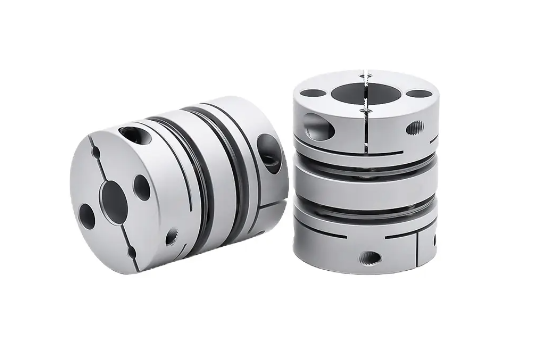Understanding Diaphragm Coupling Mechanics
How Diaphragm Couplings Transmit Torque
Diaphragm couplings are essential for transmitting torque because they use a flexible diaphragm that handles misalignment issues and compensates for thermal expansion problems. What makes these couplings special is how the diaphragm bends under stress, which lets it adjust to changing load conditions while still transferring power efficiently. Compared to standard coupling designs, diaphragm versions can take on much greater torque and operate at higher speeds, which is why engineers prefer them in demanding industrial settings. Field tests have shown time and again that these couplings perform better than older models when faced with tough operating conditions, especially in machinery that runs continuously or experiences frequent temperature changes. Many manufacturing plants have switched to diaphragm couplings simply because they last longer and require fewer maintenance stops, ultimately saving money over time.
Advantages Over Gear and Grid Couplings
Compared to gear and grid couplings, diaphragm couplings have some real benefits because they're built much simpler with far fewer moving components. What this means practically is less time spent on maintenance and generally more dependable operation. Another thing worth noting is how well these couplings handle backlash and wear issues, which makes all the difference in precision work where getting consistent results matters most. According to recent industry reports, machines equipped with diaphragm couplings experience reduced vibration levels by around 30%, which extends the lifespan of the equipment and cuts down on unexpected breakdowns. No wonder then why more manufacturers are turning to them when reliable performance and long term durability count.
Key Factors for Optimal Diaphragm Coupling Selection
Assessing Torque Capacity and RPM Limits
When picking out a diaphragm coupling, knowing exactly what torque capacity and RPM limits it can handle matters a lot for proper performance under actual loads. These types of couplings tend to be favored because they transmit high amounts of torque without needing bigger sizes, which makes them great choices for machines running at high speeds. If the coupling doesn't meet the needed torque specs, there's a good chance of mechanical problems down the road plus shorter life expectancy for the whole system. Industry data shows that going beyond the listed torque ratings usually leads to serious breakdowns, so sticking close to what manufacturers recommend just makes sense. The same goes for RPM limits too many folks overlook these numbers, but not knowing them can cause all sorts of issues from poor efficiency right up to damaged equipment. Taking time to check both torque and speed parameters thoroughly before making a selection pays off in the long run.
Evaluating Angular, Parallel, and Axial Misalignment Tolerance
Checking how much misalignment diaphragm couplings can handle is really important if we want our machinery to last longer and perform well. These types of couplings generally handle both angular and parallel misalignments better than rigid ones, which gives installers more leeway when putting systems together. The reason they work so well? They're designed to absorb small alignment differences between connected components, keeping things running smoothly even under less than ideal conditions. Studies show that getting the misalignment numbers right upfront cuts down on breakdowns significantly. For manufacturers and plant operators, taking time to properly assess these tolerances pays off big time over the years, as it means fewer unexpected repairs and downtime, plus lower overall maintenance expenses.
Material Selection for Corrosion and Temperature Resistance
The right choice of materials matters a lot for diaphragm couplings, particularly in places where corrosion happens often or temperatures get really extreme. Stainless steel and certain special alloys stand out because they last longer and work better under tough conditions. Most engineers know from experience that going with materials that resist corrosion makes these couplings much more reliable, which keeps things running smoothly even when conditions turn bad. When installing couplings where heat is a major factor, picking the wrong material can lead to breakdowns down the road. Taking time to understand what different materials can handle helps ensure these components stay functional for years across all sorts of industrial settings.
Application-Specific Performance Considerations
High-Speed Machinery Requirements
Diaphragm couplings work best in those fast spinning machines where keeping things balanced matters a lot. They handle all that speed without losing their grip on stability or accuracy. Take compressors and turbine drives for example these machines run at crazy RPMs and need something tough enough to keep going without falling apart. Getting the wrong coupling installed? That's asking for trouble. Too much vibration starts wearing down components faster than normal, and efficiency drops off pretty quickly too. Industry reports show when couplings don't match properly, parts start failing left and right. The smart move is always picking the right one from the start. Not only does this cut down on unexpected breakdowns, but it also means the whole system lasts longer before needing replacement. Equipment runs smoother overall, even under tough conditions most other setups would struggle with.
Handling Shock Loads in Turbine and Pump Systems
Diaphragm couplings handle shock loads really well, making them great choices for turbines and pumps that deal with constant load fluctuations. The way these couplings work allows them to pass along loads quickly without putting too much strain on everything else connected. What makes this possible? Well, they have built-in features that actually soak up shocks rather than letting them travel through the system. Take turbines and pumps for instance these machines often face sudden load changes during operation. When this happens, diaphragm couplings step in like shock absorbers in cars, taking the hit of those energy spikes before they can damage other parts of the machinery. Research shows that when these couplings properly manage shock loads, mechanical breakdowns become far less common. Systems running with diaphragm couplings tend to operate smoother over time, which means fewer surprises when it comes to downtime or expensive repairs down the road.
Installation and Maintenance Best Practices
Proper Alignment Techniques to Prevent Premature Wear
Getting the alignment right makes all the difference when it comes to how long diaphragm couplings last before needing replacement. When things aren't aligned properly, we start seeing problems like vibrations that just keep getting worse over time, plus the whole system runs less efficiently. This leads to bigger repair bills down the road and equipment sitting idle waiting for fixes. Laser alignment tools really change the game here because they cut down on mistakes during installation. These systems deliver pretty impressive accuracy levels that matter a lot for keeping everything running smoothly and making sure parts don't wear out faster than expected. Most experienced technicians will tell anyone who listens that checking alignment regularly isn't optional if they want to avoid headaches later on. A quick check every few months catches small problems before they become big ones, saving money in the long run while keeping operations moving forward without unnecessary interruptions.
Lubrication-Free Operation and Inspection Intervals
Diaphragm couplings stand out because they don't need lubrication during operation. This means less hassle with routine maintenance work and lower expenses over time. Still worth noting though, setting up good inspection schedules remains important for keeping these components working well. Checking them regularly lets technicians spot signs of wear or problems early on before something breaks down completely and causes expensive stoppages. Most experts recommend adjusting inspection frequency according to how hard the equipment runs and what kind of loads it handles daily. This approach helps maintain system performance while extending the life span of the coupling assembly.
FAQ Section
What is a diaphragm coupling?
A diaphragm coupling is a type of flexible coupling that utilizes a diaphragm to transmit torque, accommodate misalignments, and manage thermal expansion, offering high-performance capabilities.
What are the advantages of diaphragm couplings over gear and grid couplings?
Diaphragm couplings provide advantages such as simpler design, reduced maintenance, enhanced reliability, minimized backlash, and superior vibration reduction.
How does material selection impact diaphragm coupling performance?
The choice of materials, like stainless steel or specialized alloys, impacts performance by enhancing durability and resistance to corrosion and high temperatures, ensuring long-term reliability.
Why is proper alignment important for diaphragm couplings?
Proper alignment ensures optimal performance, prevents premature wear, reduces vibration, and avoids costly repairs due to misalignment errors.
How often should diaphragm couplings be inspected?
Inspection intervals should be based on operational conditions and load demands to identify issues early and ensure the coupling's prolonged efficiency and reliability.

